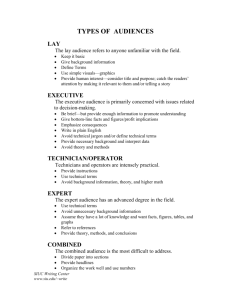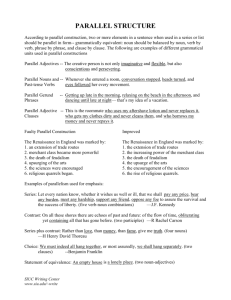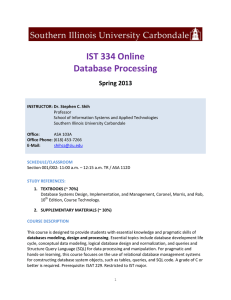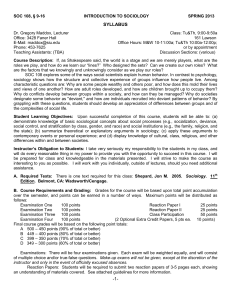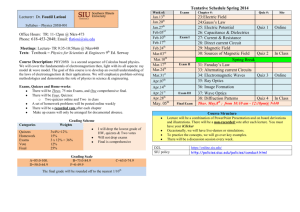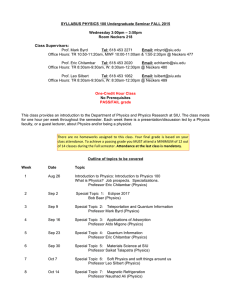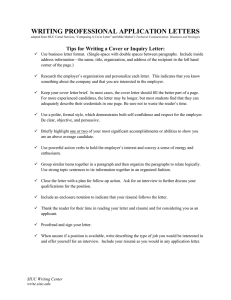Sample Lecture Notes on Taking Lecture Notes
advertisement
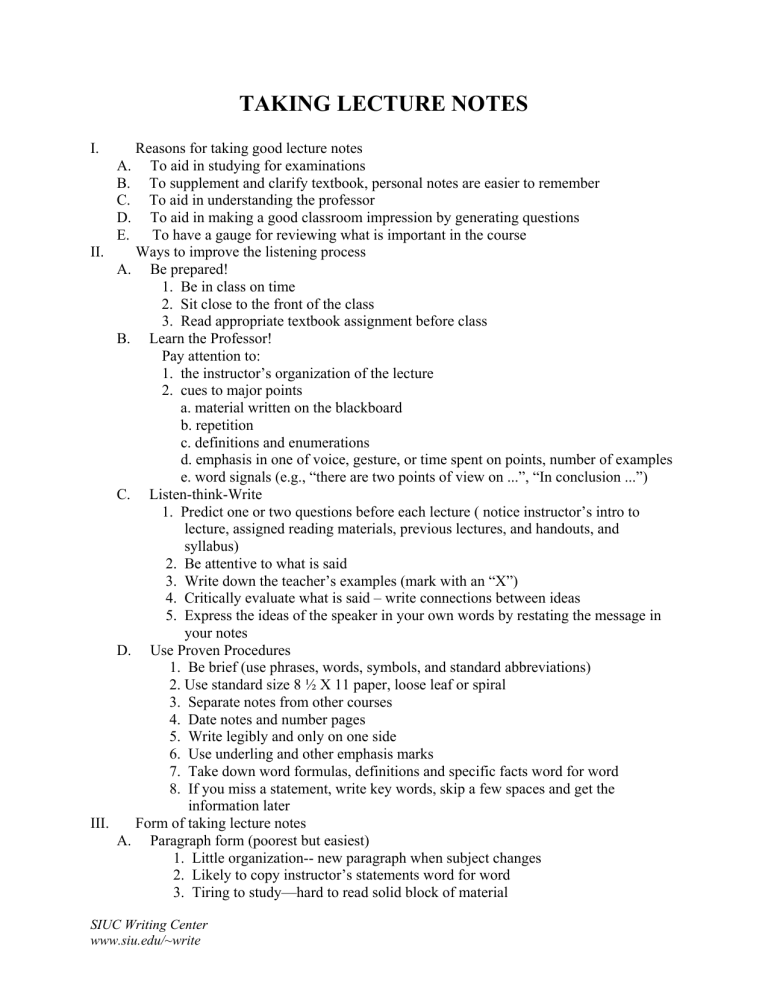
TAKING LECTURE NOTES I. Reasons for taking good lecture notes To aid in studying for examinations To supplement and clarify textbook, personal notes are easier to remember To aid in understanding the professor To aid in making a good classroom impression by generating questions To have a gauge for reviewing what is important in the course II. Ways to improve the listening process A. Be prepared! 1. Be in class on time 2. Sit close to the front of the class 3. Read appropriate textbook assignment before class B. Learn the Professor! Pay attention to: 1. the instructor’s organization of the lecture 2. cues to major points a. material written on the blackboard b. repetition c. definitions and enumerations d. emphasis in one of voice, gesture, or time spent on points, number of examples e. word signals (e.g., “there are two points of view on ...”, “In conclusion ...”) C. Listen-think-Write 1. Predict one or two questions before each lecture ( notice instructor’s intro to lecture, assigned reading materials, previous lectures, and handouts, and syllabus) 2. Be attentive to what is said 3. Write down the teacher’s examples (mark with an “X”) 4. Critically evaluate what is said – write connections between ideas 5. Express the ideas of the speaker in your own words by restating the message in your notes D. Use Proven Procedures 1. Be brief (use phrases, words, symbols, and standard abbreviations) 2. Use standard size 8 ½ X 11 paper, loose leaf or spiral 3. Separate notes from other courses 4. Date notes and number pages 5. Write legibly and only on one side 6. Use underling and other emphasis marks 7. Take down word formulas, definitions and specific facts word for word 8. If you miss a statement, write key words, skip a few spaces and get the information later III. Form of taking lecture notes A. Paragraph form (poorest but easiest) 1. Little organization-- new paragraph when subject changes 2. Likely to copy instructor’s statements word for word 3. Tiring to study—hard to read solid block of material A. B. C. D. E. SIUC Writing Center www.siu.edu/~write B. C. Sentence Form 1. A series of numbered statements 2. Best for following unorganized lecturer 3. Difficult to study by—major and minor points undifferentiated Standard Outline Form (best but hardest) 1. Use Roman numerals, capital letters, Arabic figures and small numbers 2. Use indentations to different depths; this helps distinguish major form minor points 3. Requires thinking and organization to the highest degree 4. Almost impossible to copy lecturer word for word 5. Easiest to study—content is logically organized 6. Model notes have the following organization: Date Page Class Lecture Title & Speaker wide space for questions and key words I. Notes in outline form A. B. 1. fold or line drawn IV. Reviewing Lecture Notes The best notes aren’t any good unless you use them! A. Review lecture notes IMMEDIATLEY after class 1. Edit notes, complete any unanswered questions, add after thoughts, fill in what you didn’t have time to during the lectures B. Cross-reference lecture notes and reading assignments 1. Reinforce learning 2. Identify material not understood C. Recite major points covered in lecture 1. To retard forgetting 2. To check understanding D. Before each class, while you sit and wait, review the notes form last class’ previous meeting to orient you for the upcoming class; then you’ll make more relevant notes SIUC Writing Center www.siu.edu/~write E. Do a weekly review of each weeks’ notes at the end of that week, along with a review of that weeks’ text book readings F. Periodically, and a few days before an exam, review your notes for that exam, along with a review of that weeks’ text readings G. Use the questions and key terms in the margins of your notes as ample test questions. Cover up the outline, check answer by uncovering outline V. Some Common Abbreviations to use in Note taking sol’n = solution abs = absolute w/ = with = paragraph imp = important th = theory No. or # = number = therefore = = equal X = multiply Sources: Effective Study Course, William F. Brown Quest, Academic Skills Program, Cohen, et, al. How to Study, Thomas F. Station Appalachian Sate University, Boone, North Carolina SIUC Writing Center www.siu.edu/~write
